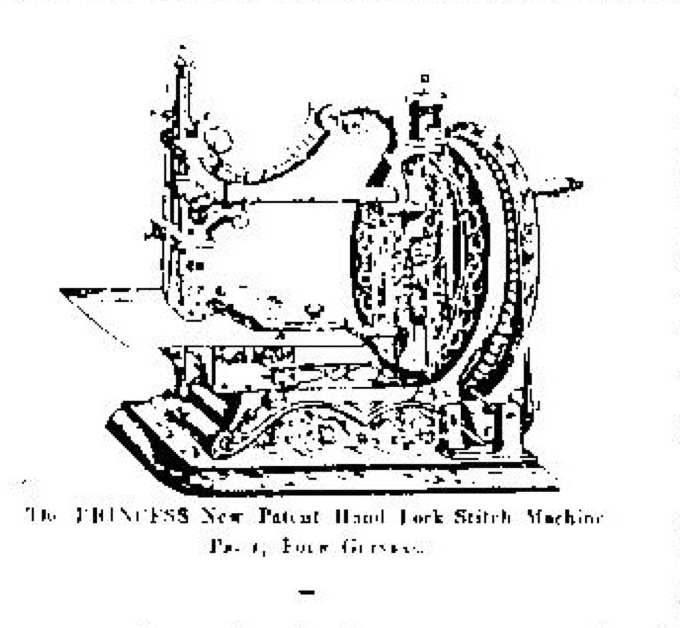Whight and Mann Story
Carol Head
THE WIGHT AND MANN company was established in 1859 at Gipping Works, Station Road, Ipswich, with a saleroom at 143 Holborn Bars, London.
George Wight patented a double-thread chain-stitch machine known as the Excelsior two years later and this was exhibited at the Great Exhibition in London in 1862 where it was described as a simple and cheap form of SM, priced from 6gns.
The Excelsior, also shown at the Paris Exhibition in 1867, used two reels of thread to produce a double-thread chain-stitch. The instruction book recommends a thicker, glazed upper thread and a thinner unglazed lower thread, in order to achieve a good stitch. The needle's rocking motion gave the left-to-right feed and was ideal for embroidery as the work could be turned in any direction. The chain-stitch was formed on the underside of the work.
However, this machine proved to be more suitable for medium-to-heavy-weight fabrics, because the movement of the needle often tor fine material. The needles, made by Morris and Yeomans of Redditch, have a very long shank and measure 3 3/4 inches in length. This machine was the first to be advertised in the 'English Mechanic' (first published in may 1865) and it was recommended as the 'best family sewing machine' by several readers.
In 1868 W&M produced the Alberta lock-stitch machine based on the American Wheeler and Wilson rotary-hook principle but with several improvements. The Alberta was a very pretty machine with an ornamental bronzed three-legged stand -- a good design with the machine always stable and the third leg at the back, allowing it to be tucked away into a corner. It was priced from 5gns and recommended as suitable for outfitters, collar makers, and for general family work. The illustration in the advertisement and instruction booklet for this machine shows the driving wheel and pitman on the left, but on my machine they are on the right.
During the late 1860s the company were also manufacturing the Princess hand lock-stitch machine which has a serpentine arm and enclosed hand wheel, priced 4gns. A rubber band has to be used to connect the hand wheel to the small wheel of the bobbin winder in order to fill the bobbin.

In 1869 they were advertising the Holborn Express SM and in 1874 the Little Darling silent lock-stitch machine, priced 5gns. Another hand lock-stitch model made in the 1870s was the Prima Donna at 4gns, also available on an ornate three-legged stand, with shell-shaped, fluted foot pedals for £5-12-0d. This machine has a G frame and circular cloth plate. W&M also made a machine on the Thomas principle, the Celebrated No. 2 machine (9gns) for boot makers and tailors.
In 1874 W&M were advertising the Celeste piano, designed and manufactured at Gipping Works, Ipswich and with the London address of 40 Brooke Street, Holborn. Mr Mann died in 1878 and Gipping Works was sold shortly afterwards. Wight and Mann became George Whight and Co of 39 Buttermarket, Ipswich and 143 Molborn Bars.
Whight began to import SMs from Germany including the ET Hughes- patented chain-driven lock-stitch machine from Junker and Ruh of Baden. This machine, bearing the George Whight emblem, is called the Columbia. The New Excelsior lock-stitch machine advertised in 1879 was also made by the same German factory. ep In 1887 George Whight and Co had another saleroom at 126 and 127 London Wall, london, and were advertising themselves as manufacturers of musical instruments including hand organs, SMs (Improved Singer low Arm and Improved Singer High Arm machines), clocks and watches. The general manager was Herman Loog. Shortly afterwards the company ceased trading.






